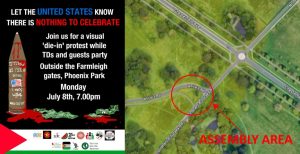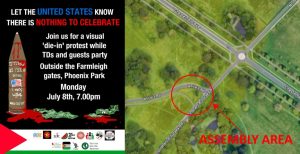








John Pilger, John McDonnell MP, Jemima Khan, Brian Eno, Ahdaf Soueif will be there. Will you? Anti-War Mass Assembly Afghanistan 10 Years On Trafalgar Square London Saturday 8 October 2011 Sign the pledge…
The ‘war on terror’ 10 years on: how "Mission Accomplished" became mission demolished
- 06 September 2011
- Paul Rogers
- USA and the War on Terror
Any way you look at it, the ten years of the ‘war on terror’ have been an unmitigated disaster for America and it’s allies, but their conclusion is too late to stop now.
6 September 2011

The atrocities in New York and Washington on 11 September 2001 led to protracted wars in Afghanistan and Iraq. Ten years after the attacks, this briefing assesses the consequences of the response from the United States and its coalition partners. It questions whether the response was either appropriate or wise and whether the results so far have been counterproductive and may indicate the need for a changed security paradigm.
Such a fundamental rethink of the way western governments respond to insecurity must go beyond the current approach in which intelligence, counterinsurgency and counter-terrorism are all beginning to merge into a seamless web of a single security posture.
Such a posture is likely to be no more successful than the policies adopted in 2001.
The Context of 9/11
Prior to the Bush administration being formed in January 2001, the Republican Party had become strongly influenced by neoconservative thinking, much of it embodied in the Project for the New American Century. This saw the United States playing a role of sustained world economic and political leadership in the unipolar world of the 21st Century. With the fall of the Soviet Union and with China embracing many elements of a mixed economy, the view from Washington was that free market democracy was the only way forward and that the United States had a duty to lead.
After the election, the administration made a series of decisions that demonstrated that in foreign and defence matters there would be a strongly unilateral approach when this was considered in US interests. In the early months of 2001, it became clear that there would be no ratification of the Comprehensive Nuclear Test Ban Treaty, the United States would withdraw from the Anti-Ballistic Missile Treaty and there would be reduced support for strengthening the Biological Weapons Treaty. Caution over negotiations on preventing the weaponisation of space and establishing an International Criminal Court were evident, and, in a move that surprised many European governments, the US withdrew from the Kyoto Climate Change Protocols. By September of that year, the determination of the Bush administration to pursue the idea of a New American Century was clearly established, and there seemed little to hinder what was honestly seen as a noble aim that would benefit the world community.
In such a context, the 9/11 attacks were particularly visceral in their impact and there was little doubt that the administration would respond with great vigour, including large-scale military action against the defined enemy of the al-Qaida movement and its Taliban hosts in Afghanistan. Those few analysts and organisations that counselled caution, including Oxford Research Group, received scant attention. Their view was that the 9/11 attacks should be seen as appalling examples of transnational criminality, the response being rooted in policing and international legal processes aimed at bringing to justice those behind the attacks. Furthermore, to see the attacks as requiring a major military response – a “war on terror” – would be assigning to the perpetrators precisely the attention that they sought, and would likely prove deeply counter-productive.
Military Responses
The initial intentions of the coalition military action in Afghanistan were to terminate the Taliban regime and destroy the core of the al-Qaida movement, with the Taliban leader, Mullah Omar, and the head of al-Qaida, Osama bin Laden, being key targets. While neither was killed nor captured during the successful termination of the Taliban regime, the early fall of that regime and the dispersal of al-Qaida meant that considerable success had been achieved by the end of 2001. In his first State of the Union address, in January 2002, President Bush was able to point to this success as proof of the rightness of US policy, and he went on to extend the war on terror to encompass an “Axis of Evil” of three states. These were Iraq, Iran and North Korea, with all three seen as sponsors of terrorism and seekers of weapons of mass destruction. In this address and in his graduation speech at the West Point Military Academy five months later, President Bush argued forcefully that the United States had the right to pre-empt future threats, with this even including further regime terminations.
In March 2003, coalition operations to terminate the Saddam Hussein regime in Iraq commenced and the regime fell within three weeks. Once again, some independent analysts, including Oxford Research Group, warned of the dangers of enforced regime termination, and there was much public opposition in Europe, but the determination of the Bush administration, aided by support from some allies, notably the Blair government in Britain, ensured that the war would proceed. By 1 May 2003, the combination of the success in Afghanistan and the apparent military victory in Iraq meant that President Bush could deliver his “Mission Accomplished” speech on the flight deck of the USS Abraham Lincoln.
War Aims
By the middle of 2003, there were clear US policy aims in terms of the military action to respond to the 9/11 atrocities. These can be summarised as follows:
- Maintain control in Afghanistan, including the development of two large military bases at Bagram and Kandahar.
- Facilitate Afghanistan’s transition to a pro-western developing society while expecting most of the support for this to come from European allies.
- Consolidate basing arrangements established during the Afghan War with Central Asian republics, ensuring a US military presence in a geo-strategically important region.
- Continue counter-terror operations against the remnants of al-Qaida and similar movements.
- Develop a long-term military presence in what would become a peaceful pro-Western Iraq, not least to limit Iranian influence in the region.
- Ensure that the Coalition Provisional Authority in Iraq oversees the development of a free-market economy with wholesale privatisation of state assets, especially oil facilities, a flat-rate tax system and minimal financial regulation.
Three elements of these aims deserve elaboration. One is that there was a confidence in Washington that the Afghan War was over, that the Taliban would not re-emerge and that European allies would bear the brunt of reconstruction and development. The second was the emphasis on creating a model free market society in Iraq, an ideological project that was seen as providing an example that would prove so successful that other states in the region would surely follow suit. The third, and possibly most important, was that by maintaining a substantial military presence in Iraq and Afghanistan and controlling the Persian Gulf and Arabian Sea through the US Navy’s Fifth Fleet, Iran would be thoroughly constrained. Given that Iran was seen as the most serious of all threats to US interests in the region, this would be a hugely positive outcome.
The 9/11 attacks had a deep and persistent impact within the United States, and many of the subsequent actions, including regime termination in Iraq, could be presented as utterly necessary responses to the atrocities. The confidence of the administration in mid-2003 stemmed from the belief that the terrible setback for US security demonstrated by the attacks had been turned round. Indeed, the Middle East and South-West Asia were being made safe in a manner which would clearly get the New American Century back on track, an outcome that was sure to prove very positive for world security.
Consequences
Al-Qaida. For the first five years after 9/11, the loose affiliates clustered around the al-Qaida movement were actually far more active than in the five years before. As well as many incidents in Pakistan, Afghanistan and Iraq, the movement was involved in attacks in Istanbul, Jakarta, Bali, Sinai, Amman, Mombasa, Casablanca, Saudi Arabia, Yemen, northern Tunisia, Madrid and London. There were failed attempts at major attacks in France, Italy, the UK and the United States, and many of the actual attacks involved overseas US interests, especially hotels. The death of Osama bin Laden in May of this year was seen in the United States as marking the end of a long war, but there are still active paramilitary groups with regular attempts at attacks on western interests. Islamist paramilitaries based in Pakistan and Yemen are of particular concern, and the Mumbai attack nearly three years ago had a profound effect on Indian perceptions of security. Groups linked loosely to the al-Qaida movement have been particularly active in Iraq in recent months, and the attack on the UN offices in the Nigerian capital, Abuja, by Boko Haram paramilitaries is an indication of the growth of yet another movement, as was the attack on the Algerian Military Academy at Cherchell in August.
Iraq. Far from seeing Iraq make a transition to a peaceful pro-western state, the outcome was a bitter seven-year insurgency combined with persistent inter-communal violence. At times during the war coalition forces had close to 200,000 troops in the country with many thousands of private security contractors also deployed. While the violence lessened in 2009 and 2010, recent reports, in mid-2011, point to a deteriorating security environment, with increased losses among US troops and the likelihood that a substantial military presence will have to be maintained. Moreover, the war has left a potent legacy of large numbers of young paramilitaries with experience of insurgency in urban environments against well-trained and well-armed professional US troops.
Afghanistan. By 2006, Taliban and other armed opposition groups (AOG) had re-emerged and established control of substantial parts of the country, leading to a steady increase in NATO forces from a base figure of around 30,000. By mid-2010, numbers had risen to 140,000, all but 40,000 being US troops. In spite of this massive surge in troops, Taliban and other AOG paramilitaries maintained control of substantial parts of the country and, when pushed back, turned to other tactics including assassinations of Afghan government officials and security personnel. The extensive use of Special Forces in night raids and of armed drones both in Afghanistan and Pakistan became tactics of choice for the US forces. While many paramilitaries were killed or captured, both tactics were deeply controversial, not least because of civilian deaths and injuries. With the 2012 re-election campaign approaching, the Obama administration declared a willingness to negotiate with Taliban and AOG elements in order to draw down force levels, but by mid-2011 it was far from clear that the opponents were serious about such engagement. Moreover, there were reports that some senior US military commanders were critical of troop withdrawals, fearing another Taliban resurgence.
Iran. Perhaps the most significant aspect of the post-9/11 wars has been the increased influence of Iran. Far from being constrained by US actions in Afghanistan and Iraq, the problems that arose in both countries have meant that Iran has more freedom to exert influence. While this is noticeable in western Afghanistan it is far more prominent in Iraq where the Shi’a majority has sought close links with Tehran. It is not a case of Iran dominating Iraqi politics since nationalist and other attitudes limit that. What is clear, though, is that the current Iraqi government is happy to maintain substantial economic and political relations with Iran and is almost certain to continue to do so in the coming years.
Costs of War
In addition to these outcomes – wholly unexpected by the wars’ architects – there is the issue of the direct human and economic costs of the wars. In mid-2011, the Eisenhower Research Project at Brown University in the United States published an assessment of these aspects of the post 9/11 conflicts. Among its conclusions were the following:
- The overall death toll, including civilians, uniformed personnel and contractors is 225,000.
- If the long term care of thousands of maimed US personnel is included, the wars have so far cost between $3.2 and $4.0 trillion dollars. This includes the estimated $600 to $950 billion federal obligations to veterans, a cost rarely included in other analyses.
- There have been 7.8 million refugees created among Iraqis, Afghans and Pakistanis.
- The wars are being funded substantially by borrowing, with $185 billion in interest already paid and another $1 trillion likely by 2020 (Source: Brown University Press Notice, 29 June 2011).
Conclusion
This briefing has sought to compare the original war aims of the Bush administration in the aftermath of the 9/11 attack with the actual outcomes. Only by doing that is it possible to get a clear idea of the unexpected consequences in terms of the longevity of the conflicts, the human costs, the financial implications and the political developments.
While the original war aims may be explainable, given the horror of the attacks and the attitudes of the Bush administration, the unexpected consequences of the decisions taken have been remarkable.
A brief war in Afghanistan is shortly to enter its second decade, seven years of war in Iraq have yet to bring a lasting peace, and Pakistan remains deeply unstable. Meanwhile, groups linked loosely with the al-Qaida movement make progress in Yemen, Nigeria, Algeria and the Horn of Africa.
Unless a comprehensive assessment of the wars is made, along the lines of this brief review but in much greater depth, it is not at all clear that lessons will be learnt in a manner likely to increase caution in responding too readily and rapidly to difficult circumstances in the future with military force.
It has become increasingly clear over the last decade that the United States and its partners must learn from the evident failure of the “war on terror” by paying more attention to the underlying causes of the conflicts, especially the factors motivating young paramilitaries to take extreme action.
Such a shift in thinking about global security should lead to efforts to avert “revolts from the margins” amid a divided and ecologically constrained world at the root: via emancipatory social-economic action, and making a transition to low-carbon economies and other forms of what is now known as ‘sustainable security.’ The anniversary of the 9/11 attacks provides an important opportunity to engage in exactly this kind of honest reflection and long-term thinking.
At present, the outlook is somewhat bleak. The United States and its coalition allies have indeed started to learn from a decade’s failures; but the lessons they are drawing show them still to be rooted in a “control paradigm”: keeping the lid on conflicts (“liddism”) rather than preventing their emergence. The control paradigm still dominates, albeit in a slightly different form. Rather than a reliance on “boots on the ground” and troop “surges”, and the sustained use of air-power and precision-guided munitions, we are likely to witness a blurring of the roles between the military and agencies such as the CIA; an assumption of paramilitary roles by intelligence agencies; and a deployment of the military’s special forces in “taking out” threats whenever and wherever they arise.
In the context of an increasingly fragile and uncertain world, and of a situation where radical groups and individuals from marginalised communities are capable of probing the innate weaknesses of advanced industrial states, these measures are seriously misconceived in terms of finding solutions to the problems western states are facing. This new way of attempting to “control” global insecurity, exemplified in the reaction to Osama bin Laden’s death, may initially prove popular. But so, once, were the wars in Afghanistan and Iraq. It is difficult to imagine that the newer type of “transnational” warfare will be any more successful than the failed policies of the last decade.

By Paul Rogers

Recent Posts

HUNDREDS KILLED AND INJURED IN GAZA TENT CAMP BY ISRAELI AIR STRIKES




